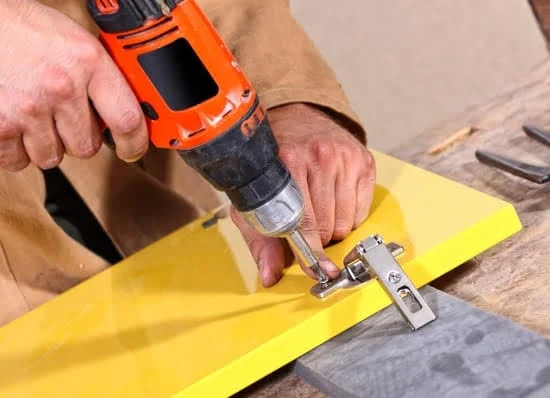Introduction
Sharpening woodworking chisels involves taking dull blades and returning them to being razor sharp. Sharpening also helps to prevent any damage caused by a blunt edge and will provide you with an invaluable tool for working with wood. As such, it is important to do this process correctly so as not to cause any damage to the chisel. Before beginning, ensure that you have the right tools: waterstones of varying grits (which are used to sharpen the chisel), a flat surface, a honing guide and lubrication oil.
The first part of the process is setting up your sharpening stones correctly on a flat surface in order to create a uniform grinding motion. Place one stone at one end of the table and another at the other in staggered steps. The stones should overlap slightly so that each one covers half of its adjacent stone’s width.
Next, assemble your honing guide around your chisel so that it’ll keep your chisel at a fixed angle as you sharpen it. Apply a small amount of oil on each side of the stone before running it along both sides of your chisel multiple times applying slight pressure throughout each stroke. You can then move onto finer grit stones until your blade is very sharp, but remember not to apply too much pressure while doing so as this could damage its delicate edges. Finally, once you can see clear wire lines running along the edge, strop the blade using leather belts impregnated with abrasive paste which will polish it further resulting in an exceptionally sharp edge!
Benefits of Sharpening Woodworking Chisels
Sharpening woodworking chisels can provide a wealth of benefits both in the long term and short term. Firstly, sharp chisels are essential for making precise and accurate cuts, as blunted tools can create jagged edges that don’t fit together properly and weaken the joint. In addition, sharpening a woodworking chisel also increases its usability and performance, as it reduces the pressure applied during use and makes carving smoother. This will help to reduce fatigue levels while crafting as well. In addition to safety benefits of keeping a woodworking chisel sharp, there is also the aesthetic benefit of having fresh edges on finely crafted pieces that won’t show any signs of wear from using dulled tools. Finally, sharpening a wooden crafting tool helps to prolong its lifespan by preventing it from becoming damaged during use or due to natural wear over time.
Sharpening woodworking chisels can also have social benefits for those who take part in crafts as a hobby or profession, as having proper technique when using these tools helps people build confidence in their craftsmanship. Additionally, being able to confidently work with sharpened tools gives crafters the ability to work more quickly without sacrificing quality; this increases productivity and morale for individuals working on larger projects. Lastly, sharpeners are able to demonstrate their skill with carving tools by creating smooth edges or finishes that command respect within the finessing community.
Different Types of Sharpening Stones and Their Unique Properties
Sharpening stones are the most common tools used for sharpening woodworking chisels. Each type of sharpening stone has its own unique properties, making some better for certain jobs than others. Waterstones are the most popular type of sharpening stone. These stones have a softer surface, which is effective in quickly removing material from steel to create a pleasing edge finish and they require water as a lubricant. Oilstones offer a slightly finer finish because they don’t remove metal as rapidly as a water stone and that also makes them ideal for deburring and honing difficult-grained hardwoods. Diamond stones are appropriate for quick grinding of high-tensile steels to increase cutting efficiency. The stones come in range of shapes, sizes, materials, and grits so you can find the best one for your project needs. Ceramic stones combine the qualities of both oil and water stones”smooth cut surfaces with no clogging or glazing over time”and are more forgiving than oil and diamond hones when it comes to acute angles or extreme point thinning applications.
Selecting the Right Grade of Sharpening Stone for the Job
It is important to select the right grade of sharpening stone for your woodworking chisels. Different types of stone come in different grits, with the lower numbers indicating coarser stones that can be used to shape or grind the edge of a blade, while higher numbers mean finer stones suitable for honing and polishing. Generally speaking, a #1000-#4000 coarse stone should be used first for removing large amounts material from the chisel edge, followed by a #3000-#6000 fine stone to refine it; after that a #8000-#12000 finishing stone can be used give an optimal sharp cutting edge. For polishing, use one of the finer stones available around #80000. After using each type of stone always clean them off with water and dry before storage.
Preparing the Chisel for Sharpening
Before attempting to sharpen a woodworking chisel, it is important to prepare it properly. This starts with removing rust, dirt and accumulated debris that is visible on the blade’s surface with a soft cloth or medium-grade steel wool. Be careful not to use anything too abrasive as this may damage the surface of the blade. Wiping down the entire tool with a light oil such as WD”40 can help loosen any remaining particles and protect against tarnishing. Next, check the back of the chisel. If there are gouges in its surface or seams, then flatten it by honing on sharpening stones using increasing finer grits until it appears flat and smooth using 220, 600 and finally 1,000 coarse-grit stones. Doing this will ensure even contact between the grindstone and bolster when sharpening the cutting edge. Finally make sure to clench the chisel securely in a bench vise with its bolster facing toward you to hold it in place during sharpening.
Step-by-Step Techniques for Sharpening a Chisel, Including Angles
Sharpening a woodworking chisel requires patience and careful attention to detail. There are several angles that need to be maintained and understood in order for the edge to be honed properly and ready for use. Here are the steps for sharpening a chisel:
1. Start by drawing an angle guide on a piece of sandpaper with a pen or pencil. Start from the corner of the paper, draw 1 inch along one side, then turn at a 90-degree angle and go 2 inches across before turning at another 90-degree angle so it forms an “L”.
2. Flip the sandpaper over so that the angle guide is on top. Hold the chisel between your thumb and index finger with your fingers at opposite corners of the bevel’s face. Position it on the end of your shop stone where you drew your angle guide on sandpaper and press down slightly to give it some stability.
3. Draw blade towards you in an arc as far as you can along one side of your angle guide while maintaining pressure evenly throughout its length on shop stone without lifting it off while going back to starting point covering other part of stone too (make sure touching whole arc). Flip sandpaper over and repeat same process with other side’s elevation by pointing tip forward this time keeping even pressure against grit’s surface until creating a perfect ogee curve both ways when done right which shows blade has been sharpened correctly at proper angles provided by being under correct pressure needed in hand honing procedure itself.
4. Once finished, hone away any small burrs or nicks left behind using higher grit stones (at least 800/1000). Run fingers along edge few times once done feeling for any noticed bumps before final assessment after stropped successfully should appear in mirror image finish proving gotten worthwhile results from work performed up until now!
Utilizing Different Grades of Sharpening Stones
Sharpening woodworking chisels is an important step in maintaining the tools and keeping them sharp. The most common way of performing this task is using different grades of sharpening stones. These stones typically come in a range of grits, from coarse to very fine, and can be used on a variety of woodworking tools including chisels. Coarse grade stones are generally used for blunt and heavily damaged edges, while medium and finer grade stones can produce razor-sharp edges on any chisel or other tool. It is important to note that the larger the gap between each stage of stone, the finer cut will be achieved when finishing the blade. Additionally, it is essential to ensure you have substantial lubrication, such as oil or water, when sharpening with these stones as this reduces heat build-up which can cause any edge to become ‘glazed’ over time and prevent it from achieving razor sharpness. After each stone has been used on both sides of the blade edge evenly then honing it down with a strop can help further refine the accuracy, leading to precision cuts every time.
Finishing Touches and Ensuring Sharpness
Before a woodworking chisel can be used to its full potential, it should be sharpened correctly. Sharpening a chisel involves honing the blade with a grinding stone and then polishing the surface with a strop. This process is important because it removes any nicks or burrs that may have occurred during use, leaving a smooth and clean edge that is ready for work. After sharpening the chisel, it’s essential to inspect the edge closely and confirm that it’s sufficiently sharp by lightly running your thumb along the blade in one direction only. Any unexpected bump or snag indicates that the edge needs further honing. To retain its sharpness, professional woodworking recommends applying wax or oil to lubricate the chisel before it is stored away; this helps protect against moisture and rust build-up. Finally, be sure to clean your chisel thoroughly after every use; this prevents dirt and sawdust particles from clogging up its crevices, ensuring excellent performance as well as maintaining safety in the woodshop.
Common Issue and Common Mistakes to Avoid
Sharpening woodworking chisels is a must for any woodworker. Not only will it help you get better results when using the chisel, but it can also prevent damages such as splitting or chipping on the wood.
Common issues when sharpening woodworking chisels are not being able to produce the desired shape and edge, burrs left on the tool after sharpening and not getting the right angle. To avoid these issues, there are a few common mistakes to be aware of. Firstly, use a quality sharpening stone that has been properly dressed with an oil-based abrasive. Secondly, make sure that your honing angle is correct ” usually around 25 degrees ” and consistent along the entire length of the bevel. If a jig is used to do this then make sure that it’s secured firmly in place so as not to shake during the process. Thirdly, take your time while sharpening and don’t rush through each stroke. Instead use steady strokes with light pressure to get an even result along the entire edge of the tool. Lastly, remember to finish off by stroping the blade using leather or canvas using hone oil or honing paste for best results. Following these tips will help with any issues experienced when sharpening woodworking chisels and lead to good results every time!
Troubleshooting Tips and Strategies
When sharpening your woodworking chisels, it is important to be sure that the stone or other sharpening surface that you are using is flat and true. A warped or uneven surface will not sharpen the blade evenly and leave it with an inconsistent edge. To ensure that you are working on a flat stone or surface, put it on a smooth concrete floor and check for any imperfections by running a straightedge along its edges. If imperfections exist, you can use sandpaper to make the surface smooth and even before beginning the sharpening process.
Once your stone or other sharpening tool is ready to use, it is important to hold your chisel correctly in order to get the desired results. It’s best to grip the handle of your chisel slightly off-center with one hand while using your other hand to grasp the metal body of the chisel near the blade. This will give you more control over its position and angle as you guide it along your sharpening medium. Keep in mind that two-handed control may be necessary when dealing with particularly large chisel blades as they often require more pressure or force during honing.
When honing your chisel’s blade, always work in alternating strokes across each face of the blade. Switching between strokes on both sides of the cutting edge helps create a uniformly shaped bevel on either side for improved performance and sharper edges overall. Additionally, try and keep your strokes consistent in both speed and pressure so that all areas around the blade are being worked equally; this will help balance out any inconsistencies caused by differences in steel composition from place to place throughout the cutting edge. Finally, once finished honing, make sure to use honing oil or lapping compound along with some light finishing strokes before calling it quits in order to further refinish and polish your chisel’s edge for optimal performance.
Conclusion and Summary of Key Points
Sharpening woodworking chisels is a crucial step in keeping them sharp, efficient and in the best condition. It’s important to ensure the right angle is maintained when honing and that the whole edge of the chisel be placed against a flat stone. Different materials such as oil stones, diamond stones or both should be used to sharpen woodworking chisels, depending on the hardness of the steel. Water stones should only be used on softer steels, since they can take away too much metal on harder steel types. In addition to honing for best results it is also recommended that burnishing and stropping are used. Burnishing will help smooth out any burrs left behind from honing and stropping will give an extra level of sharpness by removing small amounts of steel from the edges of woodworking chisels. In conclusion, regular maintenance needs to be done to keep wooden chisels in prime condition by following these steps along with oiling and storing correctly. All these methods combined will lead to finely sharpened blades every time they are needed with minimal effort expended making sure every job gets done quickly, precisely and effectively.

Hi everyone! I’m a woodworker and blogger, and this is my woodworking blog. In my blog, I share tips and tricks for woodworkers of all skill levels, as well as project ideas that you can try yourself.





